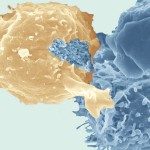Link to Pubmed [PMID] – 22427678
J. Infect. Dis. 2012 May;205(10):1520-8
BACKGROUND: Our aim was to study the impact of lifelong human immunodeficiency virus (HIV) disease history on the current immune and virological status of perinatally infected patients reaching adulthood. We evaluated blood cell-associated HIV DNA load as an indicator of cell-associated HIV reservoirs and an independent predictor of disease progression.
METHODS: The ANRS-EP38-IMMIP Study included 93 patients aged 15-24 years who were infected with HIV during the perinatal period. HIV DNA load was quantified by real-time polymerase chain reaction.
RESULTS: Eighty-five percent of patients were receiving highly active antiretroviral therapy (HAART), and HIV RNA was undetectable in the plasma of 75% of these patients. The median HIV DNA load was 2.84 (interquartile range, 2.51-3.16) log(10) copies per 10(6) peripheral blood mononuclear cells. In patients with viral suppression, HIV DNA load was independently associated with cumulative HIV RNA viremia over the last 5 years. HIV DNA load was negatively correlated with CD4 cell count in patients with active replication but not in those with undetectable HIV RNA.
CONCLUSIONS: In perinatally infected youths who are successfully treated, sustained viral suppression is associated with a low HIV DNA load. The absence of association between current HIV DNA load and CD4 cell counts suggests that the unique physiological characteristics of pediatric infection persist after adolescence.
CLINICAL TRIALS REGISTRATION: NCT01055873.





